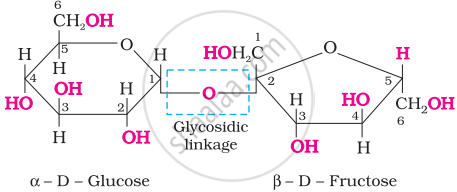Advertisements
Advertisements
प्रश्न
What are glycosidic linkages? In which type of biomolecules are they present?
उत्तर
The two monosaccharides are joined together by an oxide linkage formed by the loss of a water molecule. Such a linkage between two monosaccharides are held together by a glycosidic linkage between C1 of α-glucose and C2 of β-fructose. Since the reducing groups of glucose and fructose are involved in glycosidic bond formation, between two monosaccharide units through oxygen atom is called glycosidic linkage.

Sucrose
APPEARS IN
संबंधित प्रश्न
Glucose or sucrose are soluble in water but cyclohexane or benzene (simple six membered ring compounds) are insoluble in water. Explain.
Glycosidic linkage is found between ____________.
Which of the following gives a positive Fehling solution test?
Glucose gives silver mirror test with Tollen’s reagent. It shows the presence of ____________.
A carbohydrate that cannot be hydrolysed into simpler units is called ____________.
Structure of a disaccharide formed by glucose and fructose is given below. Identify anomeric carbon atoms in monosaccharide units.

Monosaccharides contain carbonyl group hence are classified, as aldose or ketose. The number of carbon atoms present in the monosaccharide molecule are also considered for classification. In which class of monosaccharide will you place fructose?
Which monosaccharide units are present in starch, cellulose and glucose and which linkages link these units?
Account for the following:
Glucose is a reducing sugar

Reagent X is:
